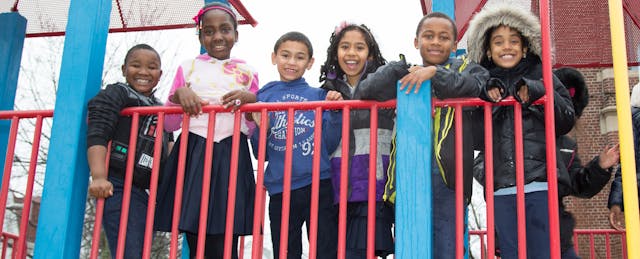ROXBURY, Mass. — Last year, a student in Yvonne Steadman’s Kindergarten class began missing a lot of days. Steadman, who teaches at Mendell Elementary School in this highly-diverse Boston neighborhood, passed along her concerns to a colleague, Madeline Gillespie, a family support coordinator.
Gillespie spoke with the girl’s mother and learned they were living in a shelter and had no way to get to school. It was less than a mile away, so the family wouldn’t ordinarily qualify for free transportation. But shelters are a special exception—students are eligible to ride on a school bus. Equipped with this information, Gillespie helped set up regular pickups and drop offs, and just like that, attendance improved.
Gillespie spends five days a week at Mendell helping the families of its 275 students negotiate complicated situations like this, but she doesn’t work for the school, or even the district. Gillespie is an employee of City Connects, a longstanding nonprofit organization that serves as a liaison between Boston Public Schools, families and, frequently, the community partners that offer much-needed assistance to low-income families that may need more support than what their schools traditionally provide.
City Connects has been around since 2001, but has even earlier roots in a two-year partnership between Boston Public Schools and researchers at Boston College from diverse disciplines, including psychology and special education. Mary Walsh, a researcher, and Pat DiNatale, a school principal, convened a group of other local principals who acknowledged the importance of providing supports to address challenges faced outside of school. These principals reported that relatively few students were receiving such supports and when they did, the supports were ad hoc, meaning there was no thoughtful integration. This working group laid the foundation for the student support City Connects now provides, which span three categories ranging in intensity from prevention to crisis intervention.

“Research demonstrates that about two-thirds of the achievement gap can be explained by the out-of-school challenges of students living in poverty,” explains Walsh, one of the original Boston College researchers and the current executive director of City Connects. “And it's absolutely the case that achievement is correlated with ZIP code, and the correlation is pretty high.” City Connects was developed to address those challenges and, according to Walsh, to enhance life chances for these students.
Nationally, City Connects serves about 85 schools in five states, including Massachusetts, and is funded through a mix of philanthropy, district dollars and government grants. According to the organization, half the students it serves identify as Hispanic; a quarter are black. In Boston, City Connects serves about 11,000 students a year in around 30 public and Catholic schools.
At Mendell, City Connects has had a continuous presence since 2013. The goal is to plug a gap identified during that first research project 20 years ago: providing an integrated and intentional support plan for every student, regardless of whether they show signs of distress.
“There are a lot of children that benefit who aren't particularly struggling in school, but really get opportunities to grow and develop,” Walsh says, adding that each student’s plan looks at a variety of factors, including academics, mental health, behavior, social-emotional learning, their physical health and home environment.
Around the country, a growing number of districts have been grappling with how to address poverty and other factors that impact students outside of school. Often referred to as wraparound supports or community schools, these emerging programs provide a mix of enrichment, early intervention and crisis management. Some match students and families with services in the community, while others embed services right in the building.
To that end, City Connects doesn’t just match people with services offered at a given school. There’s actually a sophisticated third-party network of nonprofits that partners with families and uses City Connects as a sort of liaison.
One of the most popular organizations, Cradles to Crayons, provides essentials like clothes, school supplies and books. In winter, the organization distributes entire outfits with layers and accessories to deal with the biting Boston weather. Another organization, Fresh Truck, is a sort of health food store on wheels, and provides vouchers for families to go shopping. A coordinator might arrange for a truck to be present at an event, but also serve on a wellness committee at school to boost awareness about nutrition.
Sometimes what a student really needs is a committed, local mentor—and City Connects works with groups, such as Strong Women, Strong Girls, operating off the basis of research that shows students engaged in formal mentoring programs see gains in academics, behavior and traits like resilience and empathy.
How It Works
Even though family support coordinators like Gillespie aren’t employees of the school—their salaries are paid by City Connects—they do everything possible to integrate their practice into a school’s community. Most days, Gillespie stands outside the school building as parents and kids file in for the day, greeting families and introducing herself. She serves on the school’s family engagement team as well as its positive behavior interventions and supports team. And she meets with groups of students during their usual lunch breaks.

If a teacher comes to her with a student who needs extra behavior support outside the classroom, Gillespie is ready to step in and schedule a series of one-on-one meetings with the student to discuss de-escalation techniques. It’s not traditional behavior therapy, she says—the school has a separate counselor on hand for that—but rather a limited intervention designed to help the student develop strategies for navigating stressful situations more independently.
“I think we are delineated pretty strictly,” Gillespie says about the way she works with her school counselor. As a licensed clinician, “she would be the person to communicate with a primary care physician, or in our school, her role is really with the Department of Children and Family Services.”
Naturally, a big part of the job is building relationships with families. Where some families quickly learn to ask for help from a coordinator, others are more reticent. Maybe, after months of conversation and familiarity, a parent might finally feel comfortable enough to approach Gillespie about a precarious housing situation on the verge of coming to an end or a charity or assistance program they’ve heard about, but don’t know how to apply to. In other cases, the school counselor will hear parents say they need a specific support outside of school, and pass their request on to her.
Teachers are also tremendously important sources of information for coordinators. They meet regularly and discuss students and families receiving active assistance. But teachers also facilitate new relationships between families and coordinators as well, based on their own observations.
Out of the 22 students in Steadman’s Kindergarten class, she estimates around ten of them consistently use supports arranged through City Connects—but last year it was only five. “It depends on the need of the families and what they feel comfortable sharing,” notes Steadman, adding that not all families feel comfortable asking for help. “And then you don't want to pry.”
Gillespie also works with her school’s principal—a lot. “We talk multiple times a day,” explains Julie Bott, Mendell’s principal. Some of their conversations are specifically related to City Connects work, she says, while others are more general. “I see City Connects as the work of the school, I don't see them as separate entities.” Part of that dialogue is just simple check-ins about specific families and services. But on any given week there’s a battery of meetings about how well individual support services are working and how students doing. The idea is to make sure no one is falling through the cracks.
“Just this morning we met as a support team to talk about kids who might be in mental health crisis or have behavioral needs,” Bott says. “We talk explicitly about kids who are showing patterns of chronic absenteeism, and identify case managers to reach out to the teacher, to reach out to the family and discuss the intervention plan.”
Does It Help?
Bott is convinced of the program’s tangible impacts as well. School suspensions hovered around 40 kids per year when she first started at Mendell almost a decade ago. Now, numbers are negligible—one to two students per year. The overall attendance rate has risen since City Connects began its work. And teachers report having more support to meet the needs of diverse learners socially, emotionally and behaviorally.
More generally, research conducted by Walsh in 2014 showed that students in schools that used City Connects had higher report card grades than comparable peers. Additional research by Walsh reveals notable gains for English language learners and immigrant students, and overall lower rates of chronic absenteeism associated with the program. She has also linked exposure to the program in elementary school with higher standardized test scores in middle school, when compared with peers who have not been exposed to City Connects. In all, the conclusion seems to be that the longer a student stays in the program, the better they fare.
Walsh believes the extra assistance students receive through the program helps them build a kind of resilience, as well as a network of supportive relationships that help them cope when life gets tough. “We think it has a preventive effect that helps to explain the long term positive outcomes we see for students,” she explains.
According to Bott, programs like City Connects tackle root causes that are the very real lived experience of its community—trauma from poverty, mental health services, transportation issues—which in turn allow teachers to deliver their best education in the classroom. And that’s only possible when the supports are deeply woven into the very fabric of a school.
“Most people don't know that I don't technically work for Mendell,” Gillespie says of her role. “If you're doing it well, people think you're part of the school.”
At that, Bott looks to her colleague. “Because you are.”


